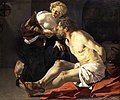鄭雅馨
年輕的女人露著胸部,衣衫不整的老人吸允著她的乳頭。
《西門與佩羅》魯本斯油畫作。首次進入博物館的人們看到這幅畫大多數都表示驚訝,有些人嘲笑和諷刺。怎麼能把這樣的畫掛在博物館門口?但是波多黎各國家的人在這幅畫面前都肅然起敬,或者感動流淚。露著胸部的年輕女人就是他的女兒,衣衫不整的老人就是她的父親。畫中的西門是為波多黎各的獨立而奮戰的英雄,卻被國王監禁在監獄裡。被判"禁食"刑。老人將慢慢死去,臨終前剛生完孩子的女兒來監獄探望父親。看到父親消瘦的軀體,解開自己的衣裳,將自己的乳汁給予父親,不願父親成為餓死鬼
《西門與佩羅》魯本斯油畫作。首次進入博物館的人們看到這幅畫大多數都表示驚訝,有些人嘲笑和諷刺。怎麼能把這樣的畫掛在博物館門口?但是波多黎各國家的人在這幅畫面前都肅然起敬,或者感動流淚。露著胸部的年輕女人就是他的女兒,衣衫不整的老人就是她的父親。畫中的西門是為波多黎各的獨立而奮戰的英雄,卻被國王監禁在監獄裡。被判"禁食"刑。老人將慢慢死去,臨終前剛生完孩子的女兒來監獄探望父親。看到父親消瘦的軀體,解開自己的衣裳,將自己的乳汁給予父親,不願父親成為餓死鬼
https://en.wikipedia.org/wiki/Roman_Charity
Roman Charity (Latin Caritas romana; Italian Carità Romana) is the exemplary story of a woman, Pero, who secretly breastfeeds her father, Cimon, after he is incarcerated and sentenced to death by starvation. She is found out by a jailer, but her act of selflessness impresses officials and wins her father's release.[1]
The story is recorded in Factorum ac dictorum memorabilium (Nine Books of Memorable Acts and Sayings of the Ancient Romans)[2] by the ancient Roman historian Valerius Maximus, and was presented as a great act of pietas (i.e., filial piety) and Roman honour. A painting in theTemple of Pietas depicted the scene.[3] Among Romans, the theme had mythological echoes inJuno's breastfeeding of the adult Hercules, an Etruscan myth.[4]
The story of Cimon is predated, however, by an almost identical story recorded by Roman historian Valerius Maximus, later retold by Pliny the Elder (23-79), of a jailed plebeian woman who was nursed by her daughter.[5]Historians note that Renaissance and Baroque depictions have more incestuous overtones.[5]
In the seventeenth and eighteenth centuries, many European artists depicted the scene.[6] Most outstandingly, Peter Paul Rubens painted several versions. Baroque artist Caravaggio also featured the deed (among others) in his work from 1606, The Seven Works of Mercy.Neoclassical depictions tended to be more subdued.[7]
In the 20th century a fictional account of Roman Charity was presented in John Steinbeck's The Grapes of Wrath (1939).[8] At the end of the novel, Rosasharn (Rose of Sharon) nurses a sick and starving man in the corner of a barn. The 1969 painting Partisan Ballad by Mai Dantsig also echoes Roman Charity.[9]
The 1973 surrealist film O Lucky Man! also contains a scene of Roman Charity when the protagonist is starving and a vicar's wife nurses him rather than let him plunder the food gathered for an offering.[10]













沒有留言:
張貼留言